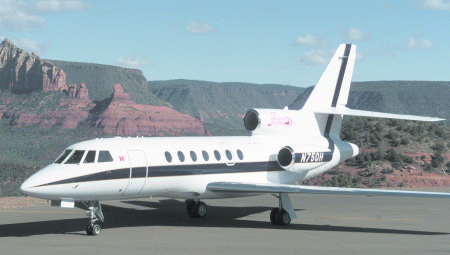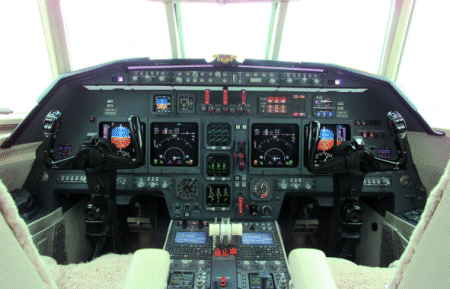Honeywell's latest re-engining effort builds firmly on the success of its Falcon 20 retrofit
Peter Henley/PHOENIX
Honeywell (formerly AlliedSignal) struck gold with its retrofit of the Dassault Falcon 20B with TFE731-5BR engines. So far, 120 Falcon 20s have been converted (Flight International, 23-29 September, 1998).
Now Honeywell is flying a prototype Falcon 50 retrofitted with three TFE731-40 engines. The philosophy is the same as with the Falcon 20: the airframe has stood the test of time; the initial design has an elegant and largely timeless shape; and there is no fatigue life - the airframe can be flown without time limit subject only to a periodic inspection. The significant difference between the two projects is that Dassault was no longer making the Falcon 20 when the retrofit programme was floated, whereas it is still producing the Falcon 50. Honeywell's Falcon 50 has a specification almost identical with the current Dassault Falcon 50EX.

The Honeywell programme essentially offers the current Falcon 50 owner an upgrade to the 50EX specification rather than trading his old aircraft for a new 50EX. Alternatively, an operator could choose to buy a used Falcon 50 and have it retrofitted by Honeywell. Either way, the retrofitted aircraft would significantly enhance performance with a worthwhile saving compared with buying new.
The basic price for the engine retrofit is about $5.3 million, explains Jim Bonadio, director for retrofit operations at Honeywell Engines and Systems in Phoenix, Arizona. The airframe owner receives credit for the original hardware removed, which are the three original TFE731-3 engines, the two outboard pylons and nacelles, the wiring harness and cockpit gauges. The centre nacelle remains as before.
The credit for these items depends on condition but would typically be $600,000-$900,000, leaving a net retrofit outlay of around$4.3-$4.6 million.
Honeywell performs the retrofit as a service bulletin item and not as a derivative or supplementary type-modification. Therefore the Honeywell airframe has to be the same as the Dassault Falcon 50EX to live under its certificate of airworthiness. The 50EX specification includes greater rudder travel. This is not to do with the more powerful engines, but to improve directional control during crosswind runway operations, says chief pilot Chad Haring.
The Falcon 50 has large vertical surfaces in the tail area and apparently has always had a tendency to weathercock in difficult conditions. The basic engine retrofit must include the rudder modification so as not to violate the type certificate. The larger arc of rudder movement requires the removal of a wedge from each inboard portion of the elevators to provide clearance. The cost of this airframe modification is included in the quoted $5.3 million.
Similarly the Dassault-built Falcon 50EX has a Rockwell Collins Pro Line IV avionics suite. The prototype Honeywell aircraft is fitted with Pro Line IV to conform with the certification requirement. It is planned that eventually the earlier Pro Line II avionics, as fitted to the standard Falcon 50, will be allowable under the existing certificate of airworthiness. Customers could be offered the choice of updating to the Pro Line IV at a cost of $2.1 million or keeping the earlier avionics. Honeywell will give quotations for further airframe work, such as repainting or interior trim, over and above the basic engine retrofit. The Dassault 50EX and the Honeywell 731-40 retrofit Falcon 50 offer major performance improvements over the standard Falcon 50 with the TFE731-3C engines.
The take-off thrust remains the same at 3,700 lb (16.5kN) but is derated from 4,250lb. The flat rating is maintained up to ISA +17°C instead of ISA +10°C for the earlier engine. At 40,000 ISA and Mach 0.8, 24% more thrust is claimed with a lower specific fuel consumption. There is an improved warranty (from three years/1,000h to five years/2,000h) and extended inspection intervals. In short, the retrofit offers better hot and high airfield performance, much improved climb time to altitude, greater cruise speed, reduced specific fuel consumption and lower cost of ownership.
Flight International flew on a pilot demonstration flight in the prototype Honeywell Falcon 50 Retrofit aircraft from Phoenix. Unfortunately this was not the usual Flight International flight test but it allowed some impression of the aircraft to be gained, and the chance to record times and fuel consumption in the climb to 45,000ft (13,700m). The prototype flown, N750H, was a well-finished demonstrator with a typical cabin configured for nine passengers, or 10 if the seat behind the co-pilot was used.
The aircraft's maximum take-off weight is 18,550kg (40,800lb). For this flight the weight was a comparatively light 14,770kg. The ambient temperature at Sky Harbor Airport, Phoenix was +16°C and the field elevation about 1,200ft. Take-off reference speeds were VR (rotate) 101kt, V2 (safety) 116kt and flap retraction 131kt (242km/h).
The TFE731-40-1C engines have digital electronic engine control (DEEC) with hydro-mechanical back-up, while the 731-3-1C has hydro-mechanical control only. The DEEC's features include automatic take-off, climb and cruise thrust-settings with power maintenance in the climb and temperature limit protection, but no auto throttle.
There was no reduced power take-off, but Haring says that it "will come in the future". The primary power indicator is N1 (determined by setting the power to the relevant "bug"). There are no thrust lever detents for power settings. The static friction levels in the thrust levers are high compared to a modern full-authority digital engine control (FADEC) system.
Honeywell pilots flew the take-off and climb to 45,000ft. They achieved a direct climb unhindered by any air traffic control restrictions. The recommended climb speed of 260 kt (480km/h)/Mach 0.68 was flown. The times were 7min to 20,000ft, 15min to 39,000ft (fuel consumed at this point was 550kg) and an impressive 20min to 45,000ft. Here the Falcon settled into the cruise at just over Mach 0.8.
Outside air temperatures were typically ISA –5°. The aircraft was without passengers or a full fuel load but it was notably sprightly. The Honeywell brochure figures for a climb to 41,000ft are about 23min for the retrofit Falcon, and 39,000ft in 39min for the standard. The aeroplane has a Mach trimmer but no cockpit indication of its operation.
I flew the Falcon from the left seat from 31,000ft during the descent to 12,000ft. The cockpit is typical Falcon with a good field of view thanks to the many windows and slim pillars. The Pro Line IV displays are neatly fitted into the instrument panel together with the standby instruments.

Each pilot has two flat panel displays while the engine and system instrumentation is on three smaller glass panel displays arranged vertically in the centre of the instrument panel. The top display shows N1 (fan speed), ITT (inter-turbine temperature) and N2 (turbine speed). The middle display is for fuel and the bottom one for oil pressure, engine vibration and hydraulic pressures. The bottom panel is partially obscured by the three thrust levers when they are in the take-off or climb position. Reverse thrust is confined to the centre engine.
The airbrakes (speed brakes) are operated by a short lever on the centre console and generated noticeable noise and aerodynamic burble when extended to the partial or fully deployed positions. The overall impression was of a well-considered, well laid-out cockpit, though with some dated features, such as the toggle switches of the overhead panel.
As I was not able to taxi, take-off or land the Honeywell Falcon 50 Retrofit, or explore the flight envelope when airborne, I was not able to gain an opinion of its handling qualities. I can vouch for the improved performance of the re-engined aircraft and one can judge the aircraft's suitability for an engine retrofit at about $4.5 million against the acquisition of a new Falcon 50EX. One key factor could be that Honeywell quote six months for a retrofit whereas the waiting time for a new Falcon 50EX can be two years.
Source: Flight International























